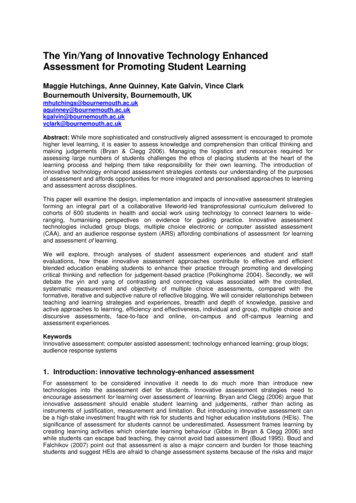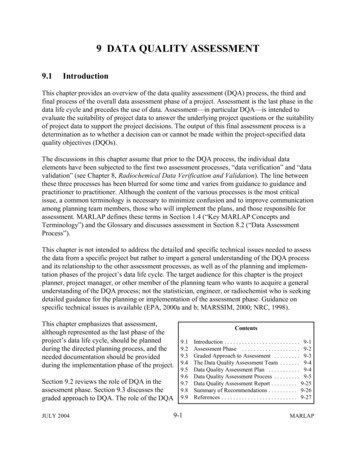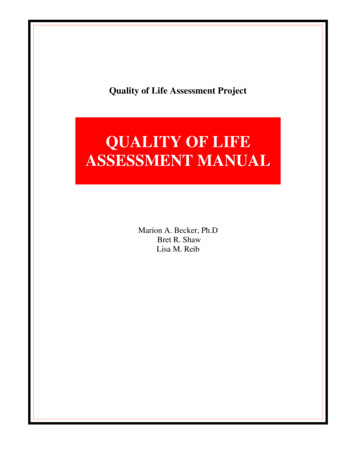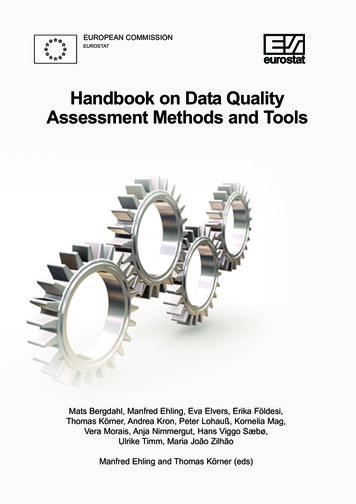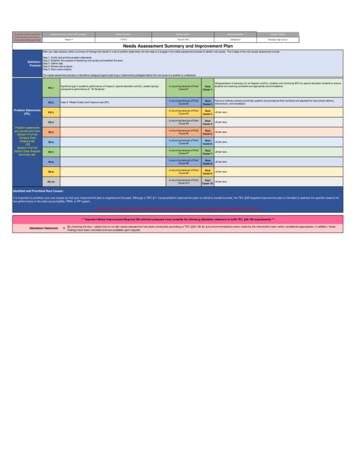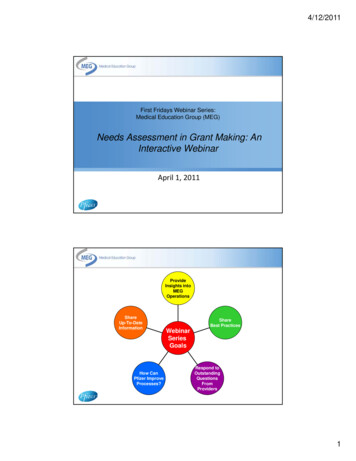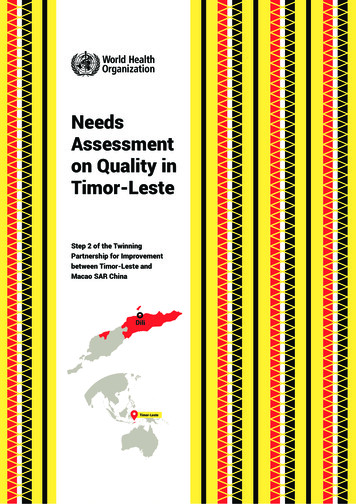
Transcription
NeedsAssessmenton Quality inTimor-LesteStep 2 of the TwinningPartnership for Improvementbetween Timor-Leste andMacao SAR ChinaDiliTimor-Leste
Needs assessment on quality in Timor-Leste. Step 2 of the Twinning Partnership for Improvement betweenTimor-Leste and Macao SAR ChinaISBN 978-92-4-151547-4 World Health Organization 2019Some rights reserved. This work is available under the Creative Commons Attribution-NonCommercialShareAlike 3.0 IGO licence (CC BY-NC-SA 3.0 IGO; igo).Under the terms of this licence, you may copy, redistribute and adapt the work for non-commercialpurposes, provided the work is appropriately cited, as indicated below. In any use of this work, there shouldbe no suggestion that WHO endorses any specific organization, products or services. The use of the WHOlogo is not permitted. If you adapt the work, then you must license your work under the same or equivalentCreative Commons licence. If you create a translation of this work, you should add the following disclaimeralong with the suggested citation: “This translation was not created by the World Health Organization(WHO). WHO is not responsible for the content or accuracy of this translation. The original English editionshall be the binding and authentic edition”.Any mediation relating to disputes arising under the licence shall be conducted in accordance with themediation rules of the World Intellectual Property Organization.Suggested citation. Needs assessment on quality in Timor-Leste. Step 2 of the Twinning Partnershipfor Improvement between Timor-Leste and Macao SAR China. Geneva: World Health Organization; 2019.Licence: CC BY-NC-SA 3.0 IGO.Cataloguing-in-Publication (CIP) data. CIP data are available at http://apps.who.int/iris.Sales, rights and licensing. To purchase WHO publications, see http://apps.who.int/bookorders. To submitrequests for commercial use and queries on rights and licensing, see http://www.who.int/about/licensing.Third-party materials. If you wish to reuse material from this work that is attributed to a third party, such astables, figures or images, it is your responsibility to determine whether permission is needed for that reuseand to obtain permission from the copyright holder. The risk of claims resulting from infringement of anythird-party-owned component in the work rests solely with the user.General disclaimers. The designations employed and the presentation of the material in this publicationdo not imply the expression of any opinion whatsoever on the part of WHO concerning the legal statusof any country, territory, city or area or of its authorities, or concerning the delimitation of its frontiers orboundaries. Dotted and dashed lines on maps represent approximate border lines for which there may notyet be full agreement.The mention of specific companies or of certain manufacturers’ products does not imply that they areendorsed or recommended by WHO in preference to others of a similar nature that are not mentioned. Errorsand omissions excepted, the names of proprietary products are distinguished by initial capital letters.All reasonable precautions have been taken by WHO to verify the information contained in this publication.However, the published material is being distributed without warranty of any kind, either expressed orimplied. The responsibility for the interpretation and use of the material lies with the reader. In no eventshall WHO be liable for damages arising from its use.Printed in Switzerland.
3CONTENTS4Acronyms5Executive summary8Introduction13Approach to the needs assessment16Rapid desk review: Timor-Leste National Health System – Quality Focus19Needs assessment country visit22Needs assessment findings45Key themes - stakeholder interviews, facility visits and desk review48Key challenges and needs51Conclusion55Next steps57Annexes63References
Needs Assessment on Quality in Timor-Leste4ACRONYMSABHRalcohol-based handrubAPPSAfrican Partnerships for Patient SafetyCHCcommunity health centreCQAHCabinet of Quality Assurance in HealthCQIcomprehensive quality improvementHNGVHospital Nacional Guido ValadaresINSInstituto Nacional de SaúdeIPCinfection prevention and controlMOHMinistry of HealthNHSSPNational Health Sector Strategic PlanPOCQIpoint of care continuous quality improvementPPEpersonal protective equipmentSARSpecial Administrative RegionSEAROWHO Regional Office for South-East AsiaSDGSustainable Development GoalsTPITwinning Partnerships for ImprovementUHCuniversal health coverageWASHwater sanitation and hygiene
EXECUTIVESUMMARY
Needs Assessment on Quality in Timor-Leste6Without quality care, universal health coverage (UHC) cannot be achieved. TheMinistry of Health of Timor-Leste, in pursuit of UHC, is working with partners,including WHO, to place a renewed emphasis on improving the quality of careprovided across the health system.As part of this effort, Timor-Leste and Macao SAR China have enteredinto a partnership arrangement using the WHO Twinning Partnerships forImprovement (TPI) approach. This approach aims to build sustainable,trusting partnerships; identify opportunities for technical collaboration tospark improvements in care; and facilitate spread of best practice acrossthe system, ensuring that the national direction on quality is informed byimplementation experience. Within the systematic TPI approach, a needsassessment has been carried out jointly between the Ministry of Healthof Timor-Leste, the Macao SAR China Health Bureau and WHO. The codeveloped needs assessment approach involved a desk review of keydocuments, stakeholder interviews and facility visits. This report outlines theneeds assessment findings and recommendations resulting from these.There are several important assets across the Timorese health systemfor improving quality. For example, there is a dedicated Cabinet of QualityAssurance within the Ministry of Health with a mandate for improving care,which has started implementing various initiatives. There have been initialefforts to build capacity in quality improvement methods, with pilot sitescurrently implementing improvement interventions. Saúde na Família, theflagship community health initiative, represents a potentially importantplatform for engaging communities. There have also been successful effortsat the national hospital to build capacity and understanding about qualityof care, supported by a development partner. Indeed, several developmentpartners are working to support improvements in quality, notably WHO andUNICEF. Importantly, there is clear enthusiasm to improve patient care amonghealth professionals and health system leaders.
7AcronymsHowever, challenges remain. In terms of leadership and governance, theCabinet of Quality Assurance in Health requires further support to deliver itsambitious quality agenda, both in terms of human resources and facilitatingengagement with key health system reforms. The systems environment forquality could be strengthened by a national strategic direction on qualityof care, to engage stakeholders, clarify governance and accountabilitystructures, prioritize interventions and facilitate effective measurement andmonitoring. Human resource capacity requires improvement to providestandardized quality care, and there are opportunities to optimize the skillsand role of nurses. There appears to be inconsistent knowledge and useof clinical guidelines and standards for common clinical conditions whichshould be addressed to enable improvements in clinical care. Building qualityimprovement capability across the country could support this effort. Prioritiesrelating to reducing harm include effective provision and practice related to IPCand WASH across the health system, with many facilities lacking provisionof reliable, safe water supplies and basic supplies like soap and personalprotective equipment. Finally, systems are not yet in place for enabling themeaningful engagement of patients, families and communities in planning,delivering and assessing care.Within the Timor-Leste–Macao SAR China TPI, the results of this needsassessment will now be used by both countries to identify action areasthat can be addressed through technical collaboration. The process hasalso played an important role in advancing the conversation on health carequality in Timor-Leste. WHO will work with the Timor-Leste Ministry of Healthto develop national direction for quality and improve overall health systemquality to enable providers to deliver better quality care.
INTRODUCTION
9IntroductionThrough the Sustainable Development Goals (SDGs), countries havecommitted to addressing quality as part of the drive to achieve universalhealth coverage (UHC). UHC means that all people and communities canuse the promotive, preventative, curative, rehabilitative and palliative healthservices they need, and that these are of sufficient quality to be effective,while also ensuring that the use of these services does not expose the user tofinancial hardship. The SDGs are inter-connected and depend on each other toaccelerate progress towards UHC and ensure improved human developmentby 2030. SDG 6 (clean water and sanitation), SDG 7 (clean energy), SDG 9(industry, innovation and infrastructure) and SDG 17 (partnerships) are alldeeply interconnected to improve health outcomes (Goal 3) for all. SDG 17recognizes that partnerships, at the global, regional and local level are oftenrequired to ensure a sustainable development agenda, building upon sharedprinciples, values, vision and goals that place people and the planet at thecentre.The release of three major reportson quality in 2018 (1,2,3) particularlythe World Bank-WHO-OECD jointPartnershipreport on Delivering quality healthservices: a global imperative for“A partnershipuniversal health coverage (1) hascan be defined ascemented the key role of partnershipsin advancing access to higha collaborativequality health services for all. Therelationship between tworeport calls on governments toor more parties basedstrengthen partnerships betweenhealth providers and health users toon trust, equality anddrive the necessary improvementsmutual understanding,needed to achieve quality in care.for the achievementHaving twinning partnershipsfor improvement between healthof a jointly agreedinstitutions are an innovativegoal. Partnershipsapproach that can be used to tackleinvolve risks as well asand improve different aspects ofhealth service delivery and clinicalbenefits, making sharedcare. TPI provides the opportunityaccountability critical.”for health service providers andinstitutions to build capacity, sustain– WHO African Partnershipsimprovements, develop innovations,for Patient Safety, 2009share learning and change the way inwhich front-line services are deliveredand received. It is with this framingin mind that Timor-Leste and Macao Figure 1: Definition of Partnership
Needs Assessment on Quality in Timor-Leste10Special Administrative Region (SAR) China, decided to enter into a twinningpartnership arrangement to facilitate improvements through focused effortsin service delivery.Coverage (%)Reproductive, maternal, newborn and child health-Latest available data (2010-2016)10050277671Child immunizationcoverage (DPT3)Care seekingbehaviour suspectedpneumonia470Family planningcoveragePregnancycareCoverage (%)Communicable diseases1001005048410Tuberculosis detection HIV antiretroviraland treatmenttherapy coverageInsecticide-treated Access to improvedbednets/indoorsanitationresidual spray coveragefor malaria preventionCoverage (%)Noncommunicable diseases10010050454401Prevalence ofnormal bloodpressurelevel in populationPrevalence of normalblood glucoselevel in populationCervical cancerscreeningTobacco non-useCoverage (%)Service capacity, access and health security1001004650660Density of hospitalbeds expressedas % of globalthreshold 18/10 000Health workerdensity expressedas % of new globalthreshold44.5/10 000Health security:IHRcomplianceAccess to essentialmedicinesFigure 2: Selected health service delivery coverage indicators for Timor-Leste. Figures are fromWHO Timor-Leste and may differ from other WHO estimates.
11IntroductionOverview of Timor-LesteTimor-Leste, a country situated in southeast Asia, covers the eastern half ofthe island of Timor. As of 2017, its population was estimated at 1 185 000with 32.8% of the population living in cities (the largest being Dili and thesecond largest, Baucau). 30.3% of the population live on less thanUS 1.90 a day. The country comprises 13 districts, each with three toseven sub-districts, 65 sub-districts, 442 sucos (villages) and 2225 aldeias(settlements) (4). Timor-Leste is home to a variety of languages. Majorlanguages spoken include Tetun and Bahasa Indonesia (spoken by 80% of thepopulation). Portuguese, Mambae and Macassae are each spoken by over10% of the population (4). Timor-Leste has one of the youngest populations inthe Asia and Pacific Region with a median age of 17.4 years. The populationbelow the age of 35 accounts for 74% of the total population, and nearly 40%are children under 15 (5).A former Portuguese colony, with a period of Indonesian rule, Timor-Leste hasmade significant strides in improving the health outcomes of its populationsince gaining independence in 2002. Indicators reflecting increasing healthservice coverage are shown in Figure 2 (6). As part of the effort to increasehealth service coverage, Timor-Leste is addressing effective coverage ofservices focusing on the overall quality of services provided. Noteworthyis the decrease in the maternal mortality ratio from 694 to 215 per 100 000women; under five mortality from 110 to 53 per 1000 live births, and neonatalmortality from 37 to 22 per 1000 live births (period: 2000–2015). Groundingthese improved service coverage efforts are health workers, whose density isreported at 20.3 per 10 000 inhabitants, an overall GDP per capita ofUS 1216.90 and total health expenditure, estimated as a share of GDP, of1.5%. As of 2015, the proportion of total population using improved drinkingwater sources and sanitation were captured at 72 and 41% respectively. Allpublic health facilities offer free health services in Timor-Leste.Overview of Macao SAR health systemThe Special Administrative Region of Macao China has a population of653 100 covering a total area of 30.8 km2. It bears the highest global lifeexpectancy at 80.3 for men and 86.4 for women. The public sector in Macaooffers one hospital, one emergency station, seven health centres and threehealth stations. The private sector plays a significant role in service deliveryoffering two hospitals, two day hospitals, 483 clinics and polyclinics, 120traditional and complementary medicine clinics and 61 dental clinics. Healthexpenditure as a percentage of total government expenditure was recorded at7.6% in 2016. Aligned with the Alma Ata Declaration of 1978, primary health
Needs Assessment on Quality in Timor-Leste12care underpins the general health system within the Special AdministrativeRegion. A political decree (decree 24/86M) was enacted in 1986 to provideprimary health care services to Macao SAR China residents in order to achievethe objective of “Health for All”. The primary health care system, which isfocused on community health care services, has 275 doctors, 231 nursesand 745 allied health workers. Broadly, Macao SAR China, recorded 1730doctors and 2397 nurses in 2017 for its health systems, up by 0.2% and2.3% respectively year-on-year; the number of doctors and nurses per 1000population was 2.6 and 3.7 respectively (7). Selected health-related indicatorsfor Macao SAR China are reflected in Figure 3 (8).IndicatorYearValuePopulation (in thousands)2016644.90Population ages, 5 -14 years (%)20146.54Life expectancy at birth (years)201683.30Under-five mortality rate (probability of dying by age 5 per1000 live births)20161.80Total health expenditure as % gross domestic product (GDP)20092.36General government expenditure on health as % of totalgovernment expenditure201610.30Human development index20090.84Per capita GDP at current market prices (USS)201489,333.00Literacy rate among adults aged 15 years (%)201397.10Maternal mortality ratio (per 100 000 live births)20130.00Population using improved drinking water source (%)2010100.00Population using improved sanitation facilities (%)2010100.00Figure 3: Selected health related indicators for Macao SAR ChinaObjectives of this reportThis report aims to highlight findings on quality from a needs assessmentconducted in Timor-Leste. The needs assessment is intended to focus onselected health facilities identified by the Ministry of Health (MOH) of TimorLeste. The systems environment, i.e. health systemwide factors affecting thedelivery of quality of health services, is lightly examined.
APPROACH TOTHE NEEDSASSESSMENT
Needs Assessment on Quality in Timor-Leste14The Twinning Partnership forImprovement (TPI) projectwas launched by WHO in2016 to support countriesto identify innovativeapproaches to improvedifferent aspects of servicedelivery through healthinstitution partnerships.TPI builds on the learningfrom the WHO AfricanPartnerships for PatientSafety (APPS) programmeand the subsequentapplication of twinningFigure 4: The TPI 6-step cyclepartnerships in health systemrecovery efforts. The key aim of TPI is to support institutions to improve thequality of their service delivery while aligning with the overall national strategicdirection on improving the quality of health services. The TPI model is basedon a 6-step cycle which begins when two partners agree on the establishmentof the partnership (9). TPI then guides the partners through a systematicprocess to identify and set the priority areas for improvement, develop anaction plan and then evaluate the activities conductedBuilding from step 1, which forms the basis of the partnership, step 2aims to identify and understand the baseline needs of the chosen partnerinstitution(s). The needs assessment provides an overview of quality healthservice delivery issues within selected health facilities. Its intended outcomeis to provide a menu of potential action areas that can be discussed,prioritized and agreed upon as part of the TPI. Ultimately, findings from theassessment contribute to the gap analysis and guide all future improvementactivities of the partnership.The needs assessment report for Timor-Leste has a dual focus – twinningpartnership for improvement and national direction for quality. Health facilitiesfunction within a broader health system environment; meaning that activitiesat the national level directly influence the state of health care quality at thesub-national and facility-level. For this reason, the assessment sought tounderstand the system environment supporting delivery of quality careand the state of quality across the health system. The needs assessmentprovides a basis for the development of an effective and sustainable twinningpartnership between Timor-Leste and Macao SAR China by examining levers,barriers, gaps and opportunities for improving quality at the national,sub-national and institutional level in Timor-Leste.
15Approach to the needs assessmentThe approach to the needs assessment included the following components. A rapid desk review analysis of key national documents on healthsystems and quality to secure a foundational understanding of the healthsystem of Timor-Leste. Selection of the various documents was informedby the MOH in Timor-Leste. Periodic teleconference calls with the MOH Timor-Leste; Macao SARChina Health Bureau; and three levels of WHO (WHO Country Office,Timor-Leste; WHO South-East Asia Regional Office (SEARO); WHOheadquarters). These periodic calls informed the overall direction of thecountry visit as part of the needs assessment. Co-development of a needs assessment approach paper informed bythe desk review and teleconferences. The approach paper outlined keyaspects, scope of the assessment, methods, proposed meetings andsteps needed to ensure effective data collection once in the country. Co-development of a “questions box.” A non-exhaustive catalogue ofquestions developed jointly with Timor-Leste MOH. The questions boxsupported deep exploration of elements which could be considered for theTPI between Timor-Leste and Macao SAR China. Stakeholder interviews with key actors from across all levels of the healthsystem and related institutions and partners. Facility visits including hospitals and health centres across Timor-Leste.These visits incorporated both stakeholder interviews and observationrelated to quality readiness and practice.To facilitate the needs assessment approach, three key principles wereidentified. Co-development with Timor-Leste and Macao SAR China partners.Agreement on the collaborative relationship between the partnersreflecting values such as trust, equality, mutuality, shared accountabilityand transparency. Country ownership with Timor-Leste MOH and Macao SAR China HealthBureau leading this partnership, with WHO facilitating and supporting thepartnership. Continual learning and development building on the desk review,documentation available in country and the significant experience relatedto quality in Timor-Leste.
RAPID DESK REVIEW:TIMOR-LESTE NATIONALHEALTH SYSTEM – QUALITYFOCUS
17Rapid desk review: timor-leste national health system – quality focusAhead of the needs assessment country mission, a rapid desk review wasconducted to get some overall understanding of the health system of TimorLeste by analysing key national documents on health systems and quality.The selected documents were identified through discussions with the MOH aswell as an online search of available documents. The documents analysed aregiven in Figure 5.1.National Health Sector Strategic Plans (NHSSP)2.National Health Accounts (NHA)3.Policy/guidance on private sector involvement in the health system4.Patient rights/charter5.Patient Safety Guidelines6.Reports from disease/population-specific programmes or programmes of developmentpartnersa.Reproductive Maternal and Child Health Guidelines7.Service Availability and Readiness Assessment or other health facility assessments8.Joint Assessment of National Health Strategies9.MOH/Quality directorate/health system organigrams10.Strategic health sector documents ona.Pharmacyb.Primary health carec.Health management information systemsd.National Drugs and Medicines Policye.Basic package for primary health care and hospitalsf.Monitoring and evaluationg.Pharmaceuticals11.WHO Country Cooperation Strategy Timor-Leste12.Reports on quality improvement initiatives (government or partners) in Timor-LesteFigure 5: Documents reviewed in rapid desk review, to support needs assessmentThe desk review applied four lenses across all the documents analysed:quality within national health priorities; quality across the WHO health systemdomains; quality within service delivery; and quality linkages withresilience1 (10), reflecting the historical context of Timor-Leste.1 The capacity of health actors, institutions and populations to prepare for and effectively respond to crises;maintain core functions when a crisis hits; and, informed by lessons learnt during the crisis, reorganize ifconditions require it.
Needs Assessment on Quality in Timor-Leste18The nature of the desk review was that it predominately analysed nationalhealth sector policy documents and plans. Therefore, the main findingsrelate to the systems envrionment for quality. These are not ordered byimportance: One, cultural and social factors play important roles in qualityof care implementation in Timor-Leste. Timor-Leste is shaped by its currentand historical context. Two, the development in health workforce, healthinformation systems, access to essential medicines and health financingin Timor-Leste remains insufficient. This has a significant influence on thecountry’s ability to deliver quality health care. Three, the strategic plan forhealth service delivery in Timor-Leste emphasizes a focus on integratedcommunity health service delivery. However, this is currently challenged byinfrastructure conditions, availability of inputs and lack of coordination. Four,Timor-Leste has created a good political and institutional environment forthe delivery of quality services, as demonstrated in its strategic plan. Theresponsibilities and capacity of quality-related authorities across variouslevels in the Timor-Leste health system require further examination. Five,values recommended by the National Health Sector Strategic Plan (NHSSP),have the potential to further inform the thinking on quality. These includeequity; cultural awareness; professionalism; integrity, ethics; excellence;and accountability. Six, maternal, neonatal and child health have long beena national priority in Timor-Leste. This serves as a possible entry point forfurther quality efforts in the country. Seven, responsibilities and capacityof quality-related authorities across various levels in the Timor-LesteHealth System require further examination. Eight, clinical and managementcompetencies of providers and user engagement need additional investment.Nine, integrated and coordinated service delivery across all levels of the healthsystem in Timor-Leste is required to ensure quality, efficiency and equity inservice provision. And finally, further work on integrating quality in emergencypreparedness and resilience planning is needed.The country needs assessment helped to further inform the review, which iscurrently being updated with relevant information from Timor-Leste. Finally,it should be noted that the desk review only considered reports written inEnglish.
NEEDS ASSESSMENTCOUNTRY VISIT
Needs Assessment on Quality in Timor-Leste20A two-week country visit was undertaken from 3–18 November 2018 inTimor-Leste. The objectives of the country visit were to understand the stateof quality in the Timor-Leste health system and thus provide a baseline for thepartnership; explore how quality health services are planned, executed andevaluated at the national, sub-national and institutional level in Timor-Leste;understand the structures, systems and institutions that can support deliveryof quality care in Timor-Leste; understand the role of various stakeholders andtheir influence on quality in the Timor-Leste health system; identify proposedpriority action areas for the twinning partnership to address; examine levers,barriers, gaps and opportunities for improving quality within the Timor-Lestehealth system; and identify external factorsand other social determinants which havean impact on the provision of quality healthStakeholderservices.insights Ministry of HealthDean of Medical, Nursing andMidwifery SchoolsInstituto Nacional de Saúde(INS)Development partnersWHO staffMunicipal healthmanagement teamFacility health managementHealth workers – nurses,midwives, doctors, cleaners,ambulance staff and morePatients and their familiesFacilities visited Guido Valadares NationalHospitalBaucau regional hospitalCommunity Health Centres(CHCs) – Riamari, Metinaro,GlenoFigure 6: Stakeholders consulted and facilities visited inTimor-LestePrior to the mission, an assessment teamwas formed which included representativesfrom Timor-Leste, Macao SAR China and thethree levels of WHO. From WHO, expertiseincluded national quality policy and strategy;service delivery, quality improvement andtwinning partnerships for improvement.Representatives from Macao SAR China wereexperts in quality improvement, nursing andmanagement. In Timor-Leste, the Cabinet ofQuality Assurance in Health (CQAH) playeda critical role with two senior technical staffmembers being allocated to co-lead andsupport the mission.Interviews were conducted with a varietyof stakeholders at all levels of the healthsystem – facility, municipal (sub-national)and national. Interviewed stakeholders arereflected in Figure 6. Engagement with andperspectives shared by service deliveryactors at various levels of the health systemprovided an opportunity to understand therealities of providing quality health services inTimor-Leste.
21Needs assessment country visitThe country visit used a variety of methods to collect data: Document reviews including the rapid desk review and any identifiednational level health-sector documents. Facility visits: using a unique approach of perspective sharing andreflection to capture insights from participants, the facility visits alloweddiscussions with key informants to determine quality gaps in theinstitutions that would be involved in the twinning partnership. Observation: conduct observation/viewing of the facility environment andpractices. Observations were used to validate broader needs assessmentfindings and not to get a representative quantitative sample or comparehealth facilities. Stakeholder interviews: key actors from across the health system wereinterviewed to explore barriers and opportunities for improving quality ofcare.The selection of facilities to visit and examine was informed by the MOH,Timor-Leste. Discussions with key stakeholders explored a range of domainsrelevant to both the twinning partnership and systems environment forquality.A detailed schedule of the mission is reflected in Annex 1. Noted limitationsof the needs assessment report include possible misinterpretation ofperspectives during the translation process. The majority of interviews weretranslated reciprocally from English to Tetun or Portuguese.
NEEDS ASSESSMENTFINDINGS
23Needs assessment findingsIn this section, findings are presented for each facility visited as part of theassessment, as well as aggregate system-level findings for the nationaland municipal (sub-national/district) levels. At the facility level, findingsrelate both to facility-specific issues that could represent potential assets orareas for action to improve quality, and to perceived br
Without quality care, universal health coverage (UHC) cannot be achieved. The Ministry of Health of Timor-Leste, in pursuit of UHC, is working with partners, including WHO, to place a renewed emphasis on improving the quality of care provided across the health system. As part of this effort, Timor-Leste and Macao SAR China have entered



